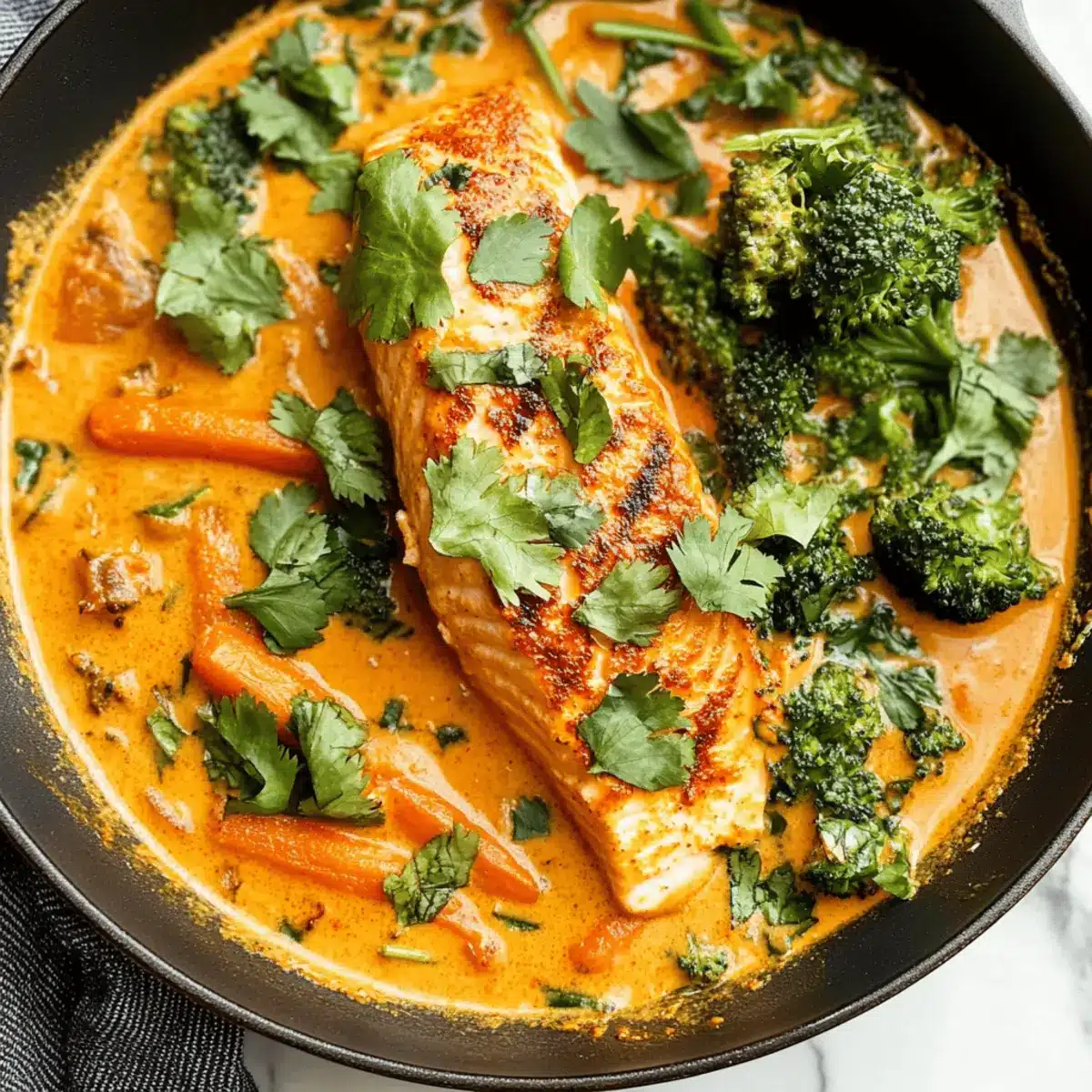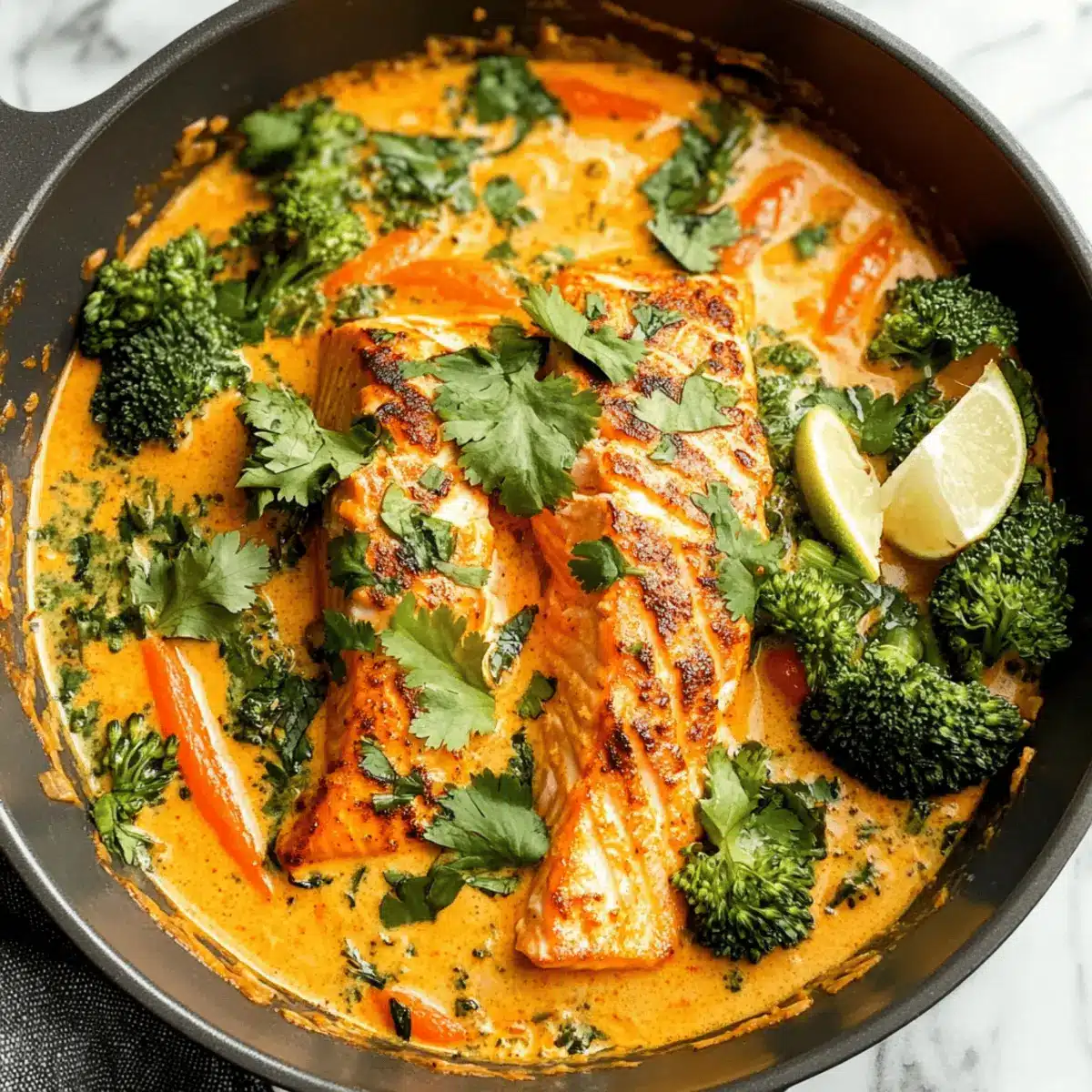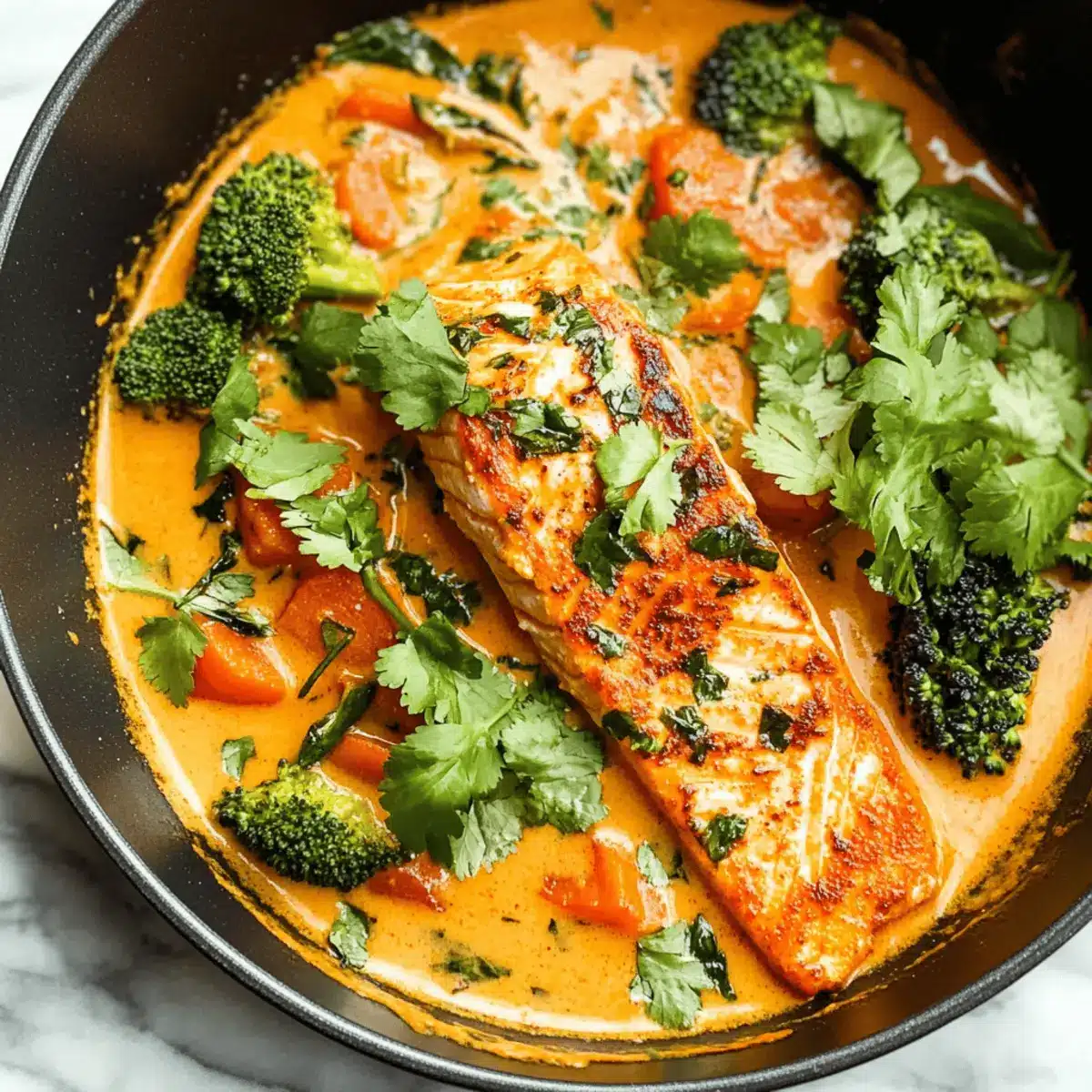As I stood in my kitchen, the aromatic whiff of Thai spices carried me straight to a vibrant market in Bangkok, bustling with flavors and colors. If you’ve ever craved the warmth of homemade comfort food without sacrificing time, this Easy Thai-Inspired Salmon Coconut Curry is your answer. With tender, pan-seared salmon wrapped in a rich, creamy coconut sauce, this dish is not only a delightful treat but also a speedy solution for busy weeknights—it comes together in just 35 minutes! Picture this: a blend of fresh ingredients mingling effortlessly on your plate, creating a wholesome meal that satisfies both the soul and the palate. So, why not swap your takeout habits for this vibrant culinary journey? Curious how to whip up this Thai delight in no time? Let’s dive in!

Why is Salmon Coconut Curry a must-try?
Quick and Easy: This dish comes together in just 35 minutes, making it a perfect weeknight solution for those busy evenings.
Rich, Creamy Flavor: The luscious coconut milk combined with aromatic Thai spices creates a rich flavor profile that will transport your taste buds straight to Thailand.
Healthy Goodness: Packed with omega-3 fatty acids from fresh salmon and nutrient-rich veggies, this recipe doesn’t just satisfy your cravings—it nourishes your body too.
Customizable Delight: Whether you prefer shrimp or chicken or want to incorporate different vegetables, this recipe allows for endless variations to suit your tastes—a true pleasure for every palate!
Comfort Food Classic: This salmon coconut curry is the perfect blend of comfort and exotic flair, because after all, nothing beats a cozy home-cooked meal! If you’re looking for more coconut-inspired dishes, check out this indulgent recipe for Coconut Shrimp Sweet.
Salmon Coconut Curry Ingredients
For the Curry
• Fresh Salmon – A premium source of protein that lends rich flavor and healthy omega-3 fatty acids.
• Olive Oil – Ideal for cooking the salmon; feel free to swap with vegetable oil if desired.
• Butter – Adds a luxurious richness; replace with more olive oil for a dairy-free version.
• Onion – Provides wonderful aromatics and sweetness; shallots can be used as a substitute.
• Garlic – Essential for depth of flavor; always opt for fresh garlic for the best results.
• Thai Red Curry Paste – The key flavor booster; green curry paste can be used for a different twist.
• Fish Sauce – Brings in that umami punch; soy sauce is a possible substitute but alters the taste slightly.
• Full-Fat Coconut Milk – The creamy base that makes this a comforting dish; choose thick, rich variants for best results.
• Brown Sugar – Balances the spiciness of the curry; white sugar works if you’re in a bind.
• Carrots – Add some vibrant color and sweetness; any quick-cooking vegetable will do, such as bell peppers.
• Broccolini – Offers a satisfying crunch; feel free to use broccoli or snap peas as alternatives.
• Lime Juice – Adds much-needed acidity and freshness; lemon juice can also be used if necessary.
• Fresh Basil – Contributes a fragrant, herbaceous note; Thai basil is wonderful but regular basil works too.
• Fresh Cilantro – A vibrant herb that adds a lovely flavor; skip it if cilantro isn’t your favorite.
To Serve
• Jasmine Rice – Accentuates the curry and makes for a hearty meal.
• Steamed Vegetables – A perfect side to balance out the richness of the curry.
Embrace the magic of salmon coconut curry tonight!
Step‑by‑Step Instructions for Salmon Coconut Curry
Step 1: Prepare the Salmon
Begin by cutting the fresh salmon into four equal pieces and patting them dry with paper towels. Season both sides generously with salt and pepper. This step ensures that the salmon has a flavorful crust when it cooks. Set the salmon aside as you prepare for cooking.
Step 2: Sear the Salmon
In a large skillet, heat 2 tablespoons of olive oil and 1 tablespoon of butter over medium-high heat. Once the butter is melted and bubbling, carefully place the salmon into the skillet, skin-side down. Cook for about 5 minutes until the skin is crispy and golden brown, then gently flip the salmon and cook for an additional 2-3 minutes until the fish is just cooked through and still slightly pink in the center. Remove the salmon from the skillet and set aside.
Step 3: Sauté the Aromatics
In the same skillet with the remaining oil, add 1 chopped onion. Sauté over medium heat for about 3 minutes, or until the onion is translucent and lightly browned. Then, add 3 minced garlic cloves and 2 tablespoons of Thai red curry paste to the skillet. Stir continuously for about 1 minute until fragrant; this will enhance the flavors of your salmon coconut curry.
Step 4: Create the Curry Base
Pour in 1 tablespoon of fish sauce and 1 can (13.5 oz) of full-fat coconut milk into the skillet. Add 1 tablespoon of brown sugar, 1 cup of sliced carrots, and 1 cup of broccolini. Stir everything well and allow the mixture to gently bubble on medium heat for about 5 minutes, or until the vegetables become tender-crisp. This will result in a rich, creamy sauce for your salmon coconut curry.
Step 5: Combine and Heat Through
Once the vegetables are cooked, stir in the juice of 1 lime to brighten the flavors. Carefully return the seared salmon back into the skillet, nestling it into the curry sauce. Let everything warm together for 2-3 minutes, allowing the salmon to absorb the delicious curry flavors.
Step 6: Final Seasoning and Garnish
Taste the salmon coconut curry and season with additional salt and pepper if needed. As you finish, sprinkle a handful of fresh basil and cilantro over the top for a burst of freshness. Serve your delightful dish immediately, ensuring each bowl is filled with that luscious, creamy sauce.

Salmon Coconut Curry Variations & Substitutions
Explore the endless possibilities to tailor this delightful dish to your preferences! Each variation invites you to unleash your creativity in the kitchen, ensuring a unique experience every time.
- Seafood Swap: Substitute salmon with shrimp or scallops for a different seafood delight. Both options cook quickly and pair beautifully with the rich curry sauce.
- Veggie Boost: Add in more vegetables like bell peppers or zucchini. They not only bring vibrant color but also contribute a satisfying crunch that complements the curry perfectly.
- Dairy-Free Twist: Use coconut oil instead of butter for a fully dairy-free version. The tropical flavor will blend seamlessly, enhancing the coconut essence in the curry.
- Heat it Up: Want a spicy kick? Incorporate fresh sliced chili or increase the red curry paste for added heat. This is perfect for heat lovers craving more excitement in their curry!
- Curry Paste Variation: Try using green curry paste instead of red for a refreshing change. The green paste will brighten up the dish while still delivering that characteristic Thai flavor.
- Herb Infusion: Mix in fresh mint or Thai basil instead of regular basil. These herbs will provide a fragrant twist, evoking memories of a sunny Thai market. You could even try a blend of herbs for added complexity!
- Sweet & Savory: Add chunks of pineapple for a sweet contrast to the spice of the curry. It creates a tropical vibe that elevates this comforting dish into a delightful tropical experience.
- Serving Style: Serve over quinoa instead of jasmine rice for a hearty and protein-packed meal. Quinoa’s nutty flavor pairs exceptionally well with the creamy coconut sauce.
Each variation keeps the essence of this beloved dish while inviting you to explore its full potential. If you’re looking for more coconut-inspired dishes, you might also enjoy this irresistible recipe for Coconut Shrimp Sweet!
What to Serve with Easy Thai-Inspired Salmon Coconut Curry
Looking to elevate your salmon coconut curry into a full dining experience? Here are some perfect pairings that balance flavors and textures.
-
Steamed Jasmine Rice:
This fragrant rice serves as the perfect bed for your curry, soaking up the rich sauce and enhancing each delightful bite. -
Garlicky Green Beans:
Lightly sautéed with garlic, these provide a satisfying crunch and bright flavor that complements the creaminess of the curry. -
Crisp Cucumber Salad:
A refreshing side of diced cucumbers with a drizzle of lime juice adds a cool contrast to the warm curry, balancing the heat beautifully. -
Coconut Rice:
For a double dose of coconut flavor, cook jasmine rice with a hint of coconut milk. This silky side mirrors the curry’s creaminess and enhances the dish. -
Mango Sticky Rice:
This sweet dessert elevates your meal with its chewy texture and fruity sweetness, creating a delightful end note after your savory main course. -
Thai Iced Tea:
The milky sweetness and floral notes of this tea offer a lovely, cooling companion to the spiciness of the curry, creating a well-rounded experience.
Each of these pairings not only complements the rich flavors of your salmon coconut curry but also crafts an inviting atmosphere that turns dinner into a special occasion!
Expert Tips for Salmon Coconut Curry
-
Pan Temperature: Ensure your skillet is well-heated before adding the salmon to prevent sticking and achieve a golden crust.
-
Cooking Time: Avoid overcooking the salmon; aim for a slight pink center. This keeps the fish moist and flakey, enhancing your salmon coconut curry.
-
Coconut Milk Choice: Use full-fat coconut milk for the richest texture. Low-fat options might not deliver the same creamy consistency.
-
Flavor Balancing: Keep fish sauce handy as it enhances the umami flavors in many Asian-inspired dishes, including your salmon coconut curry.
-
Vegetable Variations: Feel free to swap in other quick-cooking vegetables like bell peppers or zucchini to customize your dish while retaining vibrant flavor.
Make Ahead Options
These Easy Thai-Inspired Salmon Coconut Curry preparations are a game-changer for busy weeknights! You can chop the vegetables (onion, carrots, broccolini) and refrigerate them up to 3 days in advance for an effortless cooking experience. Additionally, you can season and sear the salmon and store it in the fridge up to 24 hours prior, ensuring it stays fresh and flavorful. When you’re ready to serve, simply sauté the aromatics, add the curry paste, and stir in the prepared ingredients, warming everything together. This way, you can enjoy your salmon coconut curry on demand, making homemade comfort food seamlessly convenient!
How to Store and Freeze Salmon Coconut Curry
Fridge: Store your salmon coconut curry in an airtight container for up to 3 days. When reheating, gently warm it on the stove over medium heat, stirring occasionally to preserve its creamy texture.
Freezer: If you want to enjoy it later, you can freeze your curry for up to 2 months. Just ensure it’s fully cooled before transferring it to a freezer-safe container.
Reheating: Always thaw frozen curry overnight in the fridge before reheating. Reheat gently on the stove until warmed through, adding a splash of water or coconut milk if it thickens too much.
Serving Suggestion: For the best flavor, enjoy your leftover salmon coconut curry over freshly made jasmine rice or with steamed veggies to complement the rich flavors.

Salmon Coconut Curry Recipe FAQs
What kind of salmon is best for this recipe?
Absolutely! Fresh salmon is the way to go for this salmon coconut curry. Look for vibrant, firm fillets without dark spots or dull coloration, which indicate freshness. If you can’t find fresh salmon, high-quality frozen fillets can work, just ensure they are thawed before cooking for optimal flavor and texture.
How do I store leftovers of the salmon coconut curry?
You can store your salmon coconut curry in an airtight container in the fridge for up to 3 days. When reheating, do so gently over medium heat on the stove, stirring occasionally to ensure the creamy consistency is preserved. If you notice it thickening, adding a splash of coconut milk or water can help bring it back to life!
Can I freeze the salmon coconut curry?
Yes! To freeze your salmon coconut curry, first allow it to cool completely. Transfer it into a freezer-safe container, and it can be stored for up to 2 months. When you’re ready to enjoy your curry again, thaw it overnight in the fridge, then reheat gently on the stove, stirring in a little water or coconut milk if needed to restore the creamy texture.
What should I do if the curry is too spicy?
Very! If your curry turns out spicier than you’d like, don’t fret. You can add a bit more coconut milk to soften the heat and create a creamier consistency. If you have some on hand, a teaspoon of brown sugar can also balance the spices by introducing a hint of sweetness, making it a delightful experience.
Is this dish suitable for people with gluten allergies?
Yes, this salmon coconut curry can be made gluten-free! Just be sure to omit the fish sauce or replace it with a gluten-free soy sauce alternative. Additionally, ensure that the other ingredients (like curry paste) are gluten-free certified, so you can share this delicious meal with friends and family who have dietary restrictions.
Can I use vegetables other than broccolini and carrots?
Of course! One of the joys of this salmon coconut curry is its versatility. You can swap in other quick-cooking veggies like zucchini, snap peas, or bell peppers. Just be mindful of the cooking times; add them at the right moment to ensure they don’t get mushy while still maintaining a nice crunch!

Savory Salmon Coconut Curry for Quick Weeknight Comfort
Ingredients
Equipment
Method
- Prepare the Salmon: Cut the salmon into four equal pieces and pat dry. Season both sides with salt and pepper.
- Sear the Salmon: Heat olive oil and butter in a large skillet. Cook the salmon for 5 minutes skin-side down, then flip and cook for 2-3 more minutes. Remove and set aside.
- Sauté the Aromatics: In the same skillet, add chopped onion and sauté until translucent. Add garlic and curry paste, and cook until fragrant.
- Create the Curry Base: Pour in fish sauce and coconut milk, then add brown sugar, carrots, and broccolini. Bubble on medium heat until the vegetables are tender-crisp.
- Combine and Heat Through: Stir in lime juice, return the salmon to the skillet, and warm together for 2-3 minutes.
- Final Seasoning and Garnish: Taste and add additional salt and pepper if needed. Top with basil and cilantro before serving.

Leave a Reply